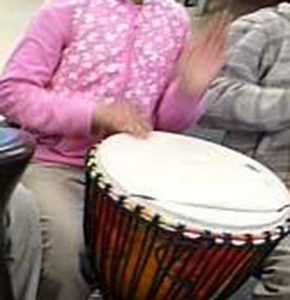IAM Drumming Instruction – How To
IAM Music Pedagogy
Drumming Instruction
 While initially the educator might allow students to “hit the drum” unsupervised, it is important that instead, or soon thereafter, the educator prevents injuries by instructing proper position and technique. Among these are proper sitting posture (e.g., straight spine, relaxed shoulders, slightly outward elbows, unbent wrists, and bouncing the hand off the drum surface upon contact) placement, angle, and depth of hand(s) and fingers when approaching and hitting a drum (discussed below), and drum placement (e.g., tilted forward and held between the knees).
While initially the educator might allow students to “hit the drum” unsupervised, it is important that instead, or soon thereafter, the educator prevents injuries by instructing proper position and technique. Among these are proper sitting posture (e.g., straight spine, relaxed shoulders, slightly outward elbows, unbent wrists, and bouncing the hand off the drum surface upon contact) placement, angle, and depth of hand(s) and fingers when approaching and hitting a drum (discussed below), and drum placement (e.g., tilted forward and held between the knees).
There are three basic tone (or stroke) types for hand percussion employed in IAM programs and sample repertoires (i.e., my compositional intention for the sounds), namely, “bass” (middle of the drum with flat or slightly rounded palm with fingers straight and close together), “tone” (edge of the drum with slightly firm flat palm, with thumb held away from fingers), and “slap” (firm flat palm with slightly spread fingers approaching at approximately a 30 degree angle to the skin, with hand stopping at the edge of drum head, and relaxed fingers hitting the skin, creating a loud, high sound; again, thumb does not hit the drum). Read more here.
Quick-Starting Beginners in Hand Drumming
Any piece with a suitable percussion pattern may suffice for teaching beginners in hand drumming. My mentor, Dr. Isaac Akrong, uses Kpanlogo rhythms in his workshops with great success, regardless of facility, age, level, social influences, or circumstances. This success leads me, like him, to teach a particular Kpanlogo drum pattern as a starting exercise for beginners in hand drumming.
The Kpanlogo drum pattern in question consists of … read more here.
Kpanlogo Bell-Drum-Rattle Combination
Kpanlogo bell, rattle, and the above described supporting drum are transcribed in Figure 20 (below). The additional rattle part (using a shaker, made from a dried hollowed gourd surrounded by a mesh of beads) consists of two sixteenths and an eighth. The rattle (or shaker) pattern is aligned such that its ending (or its cycle) coincides with the bell’s first sound and with the first sixteenth of the drum part (or Kpanlogo drum in the image below). The first bar of the rattle and bell parts contains the rhythmic figures in typical Western notation, while the second bar groups the notes so as to illustrate the acoustic groupings heard in the ensemble (especially for the rattle part).
Figure 20: Kpanlogo transcription, West African traditional:
The following illustrates bell, drum, and rattle parts:

Kpanlongo Transcription – by Nina Soyfer
The actual sound of Kpanlogo as it is … read more here
[1] The note values are not exact but approximated by myself in order to clarify the ratio between all sounds of the pattern.
Bibliography:
Agawu, Kofi. 2003. Representing African Music: Postcolonial Notes, Queries, Positions. New York: Routledge.
Akrong, Isaac K. R. Nii. 2003. Kpanlogo Dance Today: a Documentation of the Evolution of a Ga Traditional Dance Form of Ghana, West Africa. Major Research Paper, Graduate Program in Dance, York University, Toronto.
Akrong, Isaac. January 19, 2013. An informal interview on the Eele song, conducted by Nina Soyfer.
Soyfer, Nina. 2016. “Integrated Arts Pedagogy and Philosophy.” Canada: York University. http://yorkspace.library.yorku.ca/xmlui/handle/10315/32252 (accessed January 12, 2017).
Sweller, John, Jeroen J. G. van Merrienboer, and Fred G. W. C. Paas. 1998. “Cognitive Architecture and Instructional Design.” In Educational Psychology Review, vol. 10. No. 3, pp. 251-296.
Please note this page is a direct quote form Dr. Nina Soyfer’s dissertation “Integrated Arts Pedagogy and Philosophy” defended and archived in 2016. All rights are reserved and this quotation is provided here with permission for educational purposes.
Soyfer, Nina. 2016. “Integrated Arts Pedagogy and Philosophy.” Canada: York University, pp. 325-329. http://yorkspace.library.yorku.ca/xmlui/handle/10315/32252 (accessed January 12, 2017.)
 Next Post
Next Post